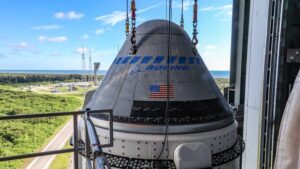Weather key issue for Starliner launch
By Jeff Foust

WASHINGTON — NASA and Boeing say a second test flight of the company’s CST-100 Starliner commercial crew vehicle remains on track for launch July 30, with weather the biggest concern.
A launch readiness review for the uncrewed Orbital Flight Test (OFT) 2 mission July 27 confirmed that both the Starliner spacecraft and its Atlas 5 launch vehicle were ready for the launch, scheduled for 2:53 p.m. Eastern July 30 from Cape Canaveral Space Force Station in Florida.
The primary concern is weather, with the potential for afternoon thunderstorms resulting in only a 40% chance of acceptable conditions for the instantaneous launch window. “We’re a little bit pessimistic going into week’s end, but we do have to be realistic,” said Will Ulrich, launch weather officer with the Space Force’s 45th Weather Squadron, at a press conference after the review. “We can hope that we’ll find a gap in the shower and thunderstorm activity that we’re anticipating.”
If weather or other issues prevent a launch on July 30, the next launch opportunities are Aug. 3 and 4. That delay is because of both orbital mechanics as well as an unavailable launch opportunity on July 31 because of what Gary Wentz, vice president of government and commercial programs at United Launch Alliance, described as a “classified operation” on the Eastern Range.
He suggested a July 31 launch could be reconsidered if that classified operation does not take place. “We’re continuing to be ready in case that operation doesn’t go through, and we could launch earlier, but unless it moves, we’ll stick with the launch on Friday [July 30] and follow up on the 3rd and 4th as backup days.”
NASA and Boeing used the briefing to reiterate what they said at a July 22 press conference regarding the readiness of the Starliner spacecraft to fly the OFT-2 mission, more than a year and a half after the original OFT mission was cut short because of software and communications problems. Boeing worked to implement 80 recommendations regarding the vehicle’s software and communications system, which have been closed out.
Implementing the recommendations involved a “relatively small set” of software changes, said John Vollmer, vice president and program manager of the commercial crew program at Boeing, although with more changes to the software for the spacecraft’s communications system. He described other changes as additional code to get the vehicle closer to the version that will fly crew.
“We tried to make the Starliner for this trip, this mission, as close to a crewed vehicle as we could,” he said. “We probably could have launched crew on this flight” other than loading oxygen needed for the capsule’s life support system.
Jinnah Hosein, a former SpaceX executive hired in November 2020 to be Boeing’s first vice president of software engineering, was also involved in reviewing the Starliner software changes, with a specific focus on the code needed for the crewed flight test of the spacecraft. “Jinnah has brought us some more tools to do that more efficiently,” Vollmer said.
Those officials, though, were more circumspect when it came to organizational reviews prompted by the unsuccessful OFT mission. At a July 15 meeting of NASA’s Aerospace Safety Advisory Panel, members said that the agency recently completed an “organization safety assessment” of Boeing and recommended that the company implement recommendations from that review before the first crewed Starliner flight.
“We really didn’t see anything in the survey that was surprising,” said Steve Stich, NASA commercial crew program manager. “Boeing has an excellent safety culture that we’ve seen.”
He declined to provide any specific findings or recommendations from the assessment, saying it was to ensure that employees interviewed would provide honest feedback. He emphasized, though, that the survey showed that “safety was the number one priority” among both NASA and Boeing personnel.
“There’s always room for improvement, so we’re going to be looking for where are those areas where we can make improvements,” Vollmer said.
July 28, 2021 at 03:51AM
via SpaceNews read more...

Post a Comment